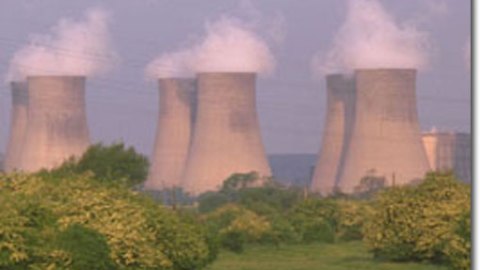Going Nuclear: Closing the Gap Between Radiation and Reason

In a series of posts over at Scientific American’s blog CrossCheck, John Horgan describes how several recent articles and books have prompted him to re-evaluate his views on nuclear energy. He specifically recommends Gynweth Craven’s Power to Save the World, discusses John Mueller’s Atomic Obsession, and describes how Wade Allison’s Between Radiation and Reason has challenged his views about the risks of radiation exposure. Horgan’s seminal End of Science partly inspired my research focus in graduate school, so when Horgan picks up on an idea trend, I pay attention.
Changing public perceptions of nuclear energy hinge on a re-framing of the issue. As American University’s Investigative Reporting Workshop uncovered earlier this year, companies and unions related to the industry have spent over the past decade more than $600 million on lobbying and nearly $63 million on campaign contributions.
Apart from the merits of the technology, this type of insider influence–while raising nuclear energy on the Congressional and White House agenda–should be cause for concern. These types of media reports also present a public image problem, reinforcing a long standing frame of reference on the issue that the industry lacks transparency and accountability.
Last year, in an open-access article published at the journal Environment, I wrote about the public perception problem surrounding nuclear energy, using the history of the debate as an example of how framing shapes judgments and policy decisions. My analysis is a side-bar to an article focused on the framing of climate change more generally.
As I describe, few Americans are likely to associate nuclear energy with slogans like “atoms for peace” or “electricity too cheap to meter.” Yet in the 1950s and 1960s, nuclear energy production was framed almost exclusively in these terms, with the technology defined as leading to social progress, economic competitiveness, and a better way of life. Those interpretations began to change in the 1970s and shifted permanently with the Three Mile Island accident. It wasn’t until 2001, under the Bush administration, that the train of thought on the issue started to reverse course:
When news reports of Three Mile Island galvanized national attention, the prevailing frames of public accountability and runaway technology became the major modes of interpretation. In a classic example of a frame device instantly signaling runaway technology, a Time magazine cover featured an ominous picture of the Three Mile Island reactor and the headline “Nuclear Nightmare.” The accident helped set in motion a dominant media narrative that went on to spotlight additional examples of construction flaws, incompetence, faulty management, and potential risks at nuclear power plants across the country.4
The Chernoybl disaster of 1986 only strengthened the frames of public accountability, runaway technology, and scientific uncertainty. The event generated worldwide attention, with few news reports contextualizing the comparative safety record of the American nuclear energy industry, effectively leaving the prevailing frames unchallenged.5 The last nuclear power plants to be built in the United States were constructed in the 1970s, though more than 100 power plants remain in operation today.6
At the start of 2000, however, new focusing events began to shift the interpretative packages and mental categories applied to nuclear energy. In 2001, in reaction to rising energy costs and rolling blackouts in California, the George W. Bush administration launched a communication campaign to promote nuclear power as a middle way path to energy independence.7 The terrorist attacks of September 11, 2001, dampened the viability of this frame package, as experts and media reports focused on nuclear power plants as potential terrorist targets.8 But since 2004, as energy prices have climbed and as U.S. dependence on overseas oil has been defined by political leaders as a major national security issue, a renewed emphasis on the energy independence interpretation has surfaced. As of 2007, utility companies submitted more than 20 applications to build additional nuclear reactors across the country to the U.S. Nuclear Regulatory Commission.9
The effort by the second Bush administration and the nuclear energy industry to reframe the relevance of nuclear energy has been complemented by an attempt to similarly sell nuclear energy as a middle way solution to greenhouse gas emissions. Former U.S. Environmental Protection Agency administrator Christine Todd Whitman, along with Greenpeace co-founder Patrick Moore, are among the sponsors of this interpretative package, arguing nuclear energy is “cleaner, cheaper, and safer” than coal-powered energy.10 According to their argument, if U.S. citizens are going to satisfy their energy demands while achieving the goal of cutting greenhouse gas emissions, the country needs to reinvest in nuclear energy.11 While running for U.S. president, Senator John McCain (R-AZ) promoted a similar middle way interpretation, declaring in a 2008 campaign speech, “If we’re looking for a vast supply of reliable and low-cost electricity—with zero carbon emissions and long-term price stability—that’s the working definition of nuclear energy.”12
However, several oppositional frames invoked in the 1970s still resonate. Groups like the Union of Concerned Scientists continue to promote uncertainty and public accountability interpretations, demanding that nuclear plants be tightly regulated in light of safety problems, the “public’s right to know,” and a “failure of regulators to take effective action” on potential risks.13 Other environmental groups emphasize not only the potential runaway dangers of nuclear energy, but also question its cost-effectiveness. They emphasize that nuclear power is not safe, not cost effective (because of the need for government subsidies), and not needed.14
What do readers think? Is concern over nuclear energy overblown? Apart from the merits of the technology, in the wake of the BP oil disaster, should we be concerned about too much industry influence and not enough oversight if government investment moves forward? Is a re-framing of the issue the key to opening a space for more reasoned discussion about the technology?
One advocate for nuclear energy is James Hansen. Watch his interview on the topic with Big Think below and then share your own views.
* Hat tip to Andrew Revkin at his Facebook page for pointing to the Horgan posts.
Citation:
Nisbet, M. (2009). Communicating Climate Change: Why Frames Matter for Public Engagement Environment: Science and Policy for Sustainable Development, 51 (2), 12-23 DOI: 10.3200/ENVT.51.2.12-23
See also:
New Study Provides Clues on How to Build Support for Nuclear Energy
AU Report on the Lobbying Strategy of the Nuclear Industry




